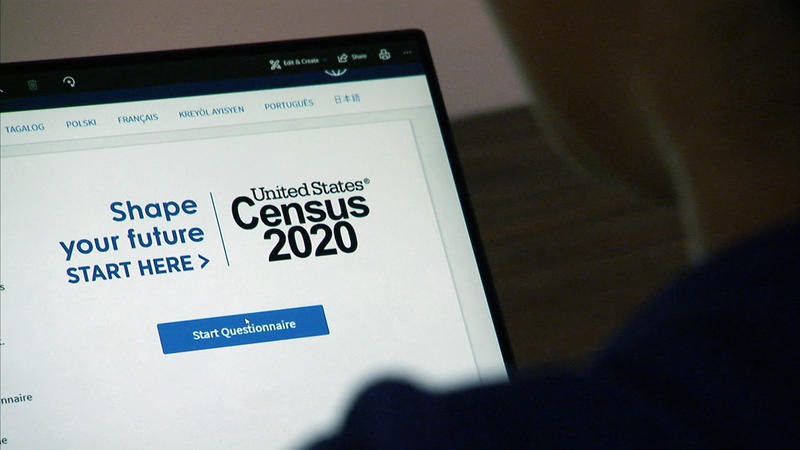
Yes, There’s Still A 2020 Census. Pandemic Necessitates Creativity In State Promotion
READ ON
Give yourself a pat on the back if you have already responded to the 2020 census. Residents of Pacific Northwest states are doing an above average job fulfilling their civic duty. But there is still a long way to go amid a virus pandemic that has forced many adjustments.
A near real time map of 2020 census self-response rates shows that 42% of Washington state and Idaho households at known addresses have completed the census as of April 1. The rate is 40.5% for Oregon, compared to the national average of 38% to date.
April 1 is Census Day, the reference date for where to record the place you usually live and sleep. Census Day is not a deadline for the decennial count of everyone living in the U.S. The U.S. Census Bureau launched its questionnaire response portals weeks ago and will continue counting deep into summer.
In a normal year, thousands of temporary census takers would fan out across the Northwest and the nation in April, May and June to follow up with households that didn’t respond on their own to the census. However, census worker training and field operations are on hold because of the coronavirus. The pandemic is forcing state and local groups to change their census outreach on the fly too, to make sure everyone is counted by midsummer.
Long before anyone had ever heard of COVID-19, Oregon, Washington and California budgeted millions of state taxpayer dollars to boost the response rate to the federal population count. State agencies awarded grants and contracts to community groups and civic associations to promote the 2020 census and help people in disadvantaged or hard-to-count groups fill out their census questionnaires. This was to be face-to-face work mostly, which is now deemed unsafe.
“What’s been completely undone is the ability to do large events,” said Marc Baldwin, who oversees census outreach funding in the Washington state budget office in Olympia. “So, all over the state about 500 organizations that we’ve been working with are changing their plans to do more online and virtual outreach or talking to people over the phone.”
Groups like Seattle-based OneAmerica and Ashland-based We Count Oregon had hired temp workers to go door-to-door. Those folks are now phone banking and texting to encourage people to answer the census.
OneAmerica Communications Director Robin Engle said her nonprofit is still determined to help 2,000-3,000 immigrants and refugees in Washington state respond. She said the necessary pivot away from face-to-face contacts is complicated by uneven access to tools like video conferencing.
“We’re still trying to figure out what our path forward will be in these times,” Engle said in a telephone interview while working from home. “We’re committed to make sure our communities get counted.”
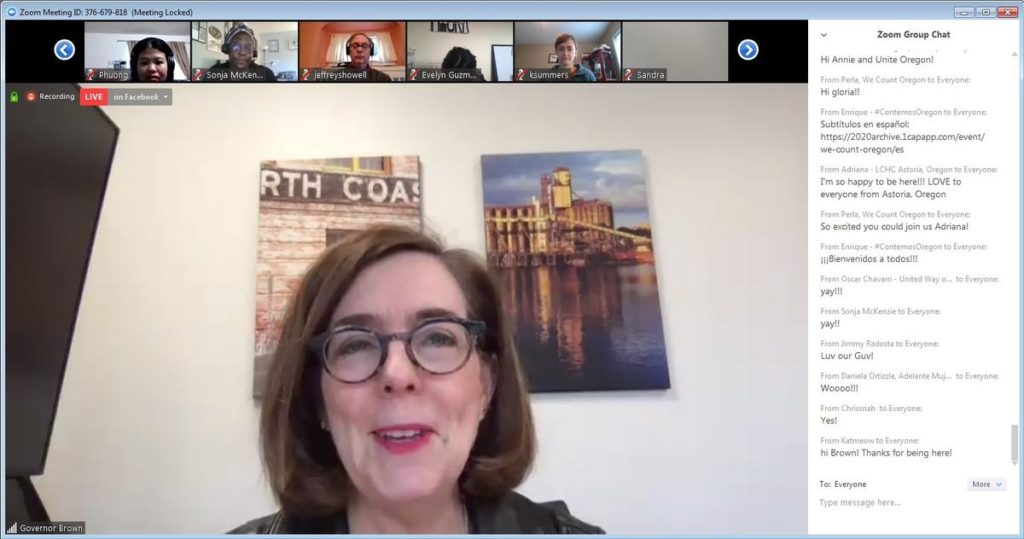
Oregon Gov. Kate Brown addressed a virtual Census Day party on Wednesday that was originally envisioned as an in-person event before the coronavirus outbreak. CREDIT: We Count Oregon
On Wednesday, We Count Oregon hosted a virtual Census Day party to share encouragement and celebrate participation, particularly by communities of color. The two-hour party was peppered with livestreamed music and speeches, including from Gov. Kate Brown.
“Especially in these unprecedented times, I am gravely concerned that an undercount in our census will impact everyone, but especially our hard-to-count communities with fewer funds for critical public services they rely on like Medicaid, SNAP (food stamps) and Section 8 housing vouchers,” Brown told the partygoers.
In Spokane, the West Central Community Center is heavily promoting the 2020 census to its Facebook followers. Last week, Spokane County residents could enter a raffle to win a Safeway gift card by posting a picture to the center’s Facebook page of themselves holding their 2020 census invitation letter, which most households received at least one of in March.
Scratched for now are plans by many of the allied groups to promote the 2020 census at farmers markets, to open census assistance centers at libraries, food banks and nonprofit offices to help people fill out their questionnaires online, or to deploy roaming ambassadors with iPads to festivals.
Baldwin said some census outreach money held in reserve is now being allocated to buy more radio, TV, print and social media promotion. A new radio spot airing in Seattle sponsored by an offshoot of the group Black Lives Matter Seattle-King County specifically mentioned the coronavirus.
“It’s going to take time to recover,” the narrator intoned over soft piano chords. “We can all play just a small part in making sure our families and communities have the resources we all need by being counted in the 2020 census.”
Census numbers guide the distribution of billions of federal dollars and determine how many congressional seats each state gets. Each person counted leads to significant resources to support programs and services. Oregon is on track to gain an additional U.S. House seat through reapportionment next year if current population projections hold.
From the start, some advocacy and civil rights groups worried large numbers of people would be missed and their communities be deprived of money and political power because of distrust of the federal government. The coronavirus outbreak has introduced a whole new layer of complications.
“It’s too early to tell,” said Washington State 2020 Census Coordinator Lisa McLean, when asked if the coronavirus pandemic will cause an undercount. “It’s concerning. When are they going to be able to get enumerators out? Because there will always be somebody who is not going to want to respond. So, there is always going to have to be some knocking on doors and we just don’t know when that will be allowed to happen again.”
California made the biggest commitment of state resources to make sure hard-to-reach populations are counted in the 2020 census. The $187 million budget for the California Census Office dwarfs the spending by any other state for this purpose.
Washington and Oregon’s state-level Complete Count committees are also richly funded compared to most other states. The Washington Legislature allocated $15.5 million toward 2020 census activities. The state of Oregon seeded its Complete Count Committee with $7.5 million. In both Northwest states, private and municipal donors chipped in several million more dollars.
We Count Oregon campaign manager Esperanza Tervalon-Garrett said the Census Bureau should tack an extra week on the back end of the counting process for every week people are required to stay in their homes to stay safe from the pandemic this spring.
“We’re trying to figure this out, figure it out together, and time is certainly not on our side,” Tervalon-Garrett told OPB’s Think Out Loud talk show on Thursday. “This whole pandemic is going to have a huge impact on our ability to have a full count.”
In light of the COVID-19 outbreak, Census Bureau managers slightly pushed back the end of counting from July 31 to August 14. The agency is still planning to deliver the final population numbers for each state to the president and Congress by the legal deadline of December 31, 2020.
“It has never been easier to respond on your own,” said Tim Olson, associate director for field operations at the Census Bureau during a media briefing. “You can respond online, by phone or by mail without ever meeting a census taker.”
A Western region Census Bureau deputy operations director said in an email that the self-response rate for Washington state as of Tuesday was within one percentage point of the forecast for where it would be at this time. Throughout the Northwest, residents are taking advantage of the online response option, which is available for the first time during the 2020 census.
Related Stories:
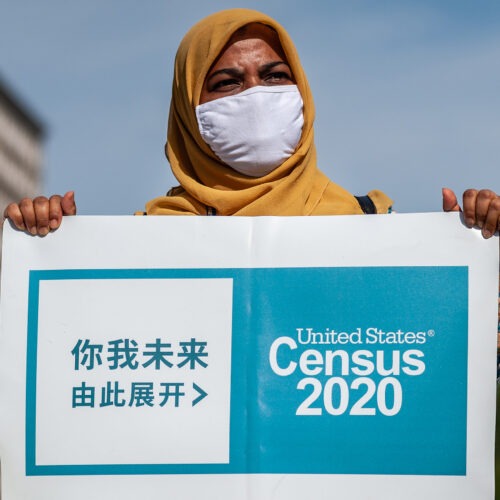
6-Month Delay In Census Redistricting Data Could Complicate 2022 Mid-Term Elections
Dogged by the coronavirus pandemic and the Trump administration’s interference with the census schedule, the latest expected release date — six months past the March 31 legal deadline — could throw upcoming elections into chaos in states facing tight redistricting deadlines for Congress, as well as state and local offices.
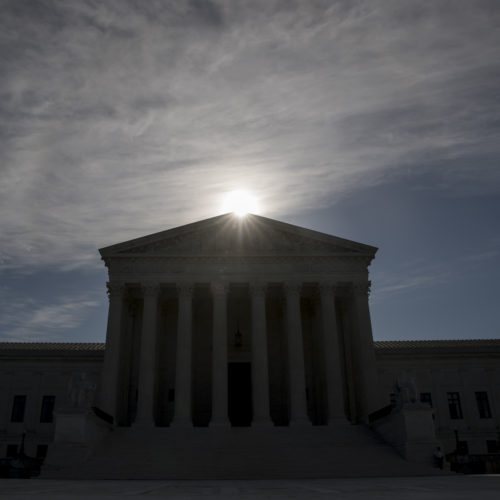
Supreme Court Weighs President’s Plan To Cut Undocumented Immigrants From Census Count
Justices expressed doubts about a plan to cut undocumented immigrants from a key census count — one that would exclude them for purposes of drawing new congressional districts.
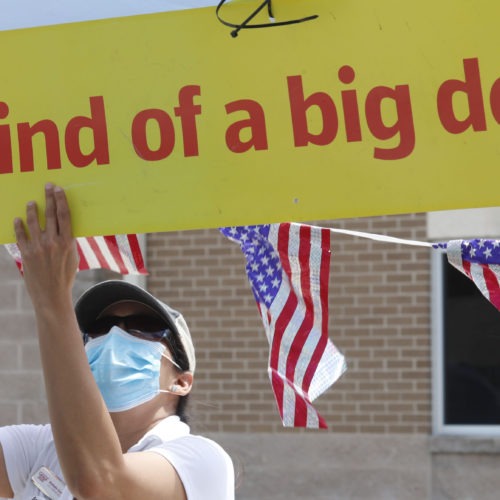
Supreme Court Speeds Up Case On President Trump’s Push To Alter Census For House Seats
The justices will hear oral arguments Nov. 30, increasing the potential for Trump to try to omit unauthorized immigrants from the census numbers used to reallocate House seats during his current term.















